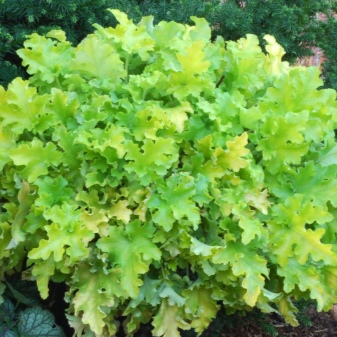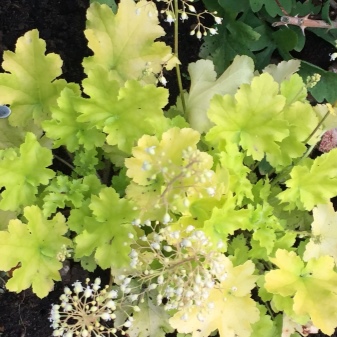Geuchera "Marmalade": description of varieties, recommendations for growing

Heuchera "Marmalade" is a perennial plant with beautiful leaves, belonging to the Kamnelomkovy family. This name was given to the perennial in honor of the German botanist of the 18th century Geicher I.G. There are about 37 species of this plant. The western part of North America is considered the birthplace of Heuchera. In nature, the shrub grows on stony soils, on mountain slopes with a minimum amount of nutrients. Thanks to the different shades of flowers on its lush leaves, the plant looks like a marmalade. It is because of the chic leaves and high decorative qualities that the flower is very popular among gardeners.



Description
Heuchera "Marmalade" is a complex hybrid variety obtained from crossing three types of Heuchera. It is the tallest species of its kind, reaching a height of 45 cm. It forms a lush, rounded bush. The leaves are lobed with corrugated edges, have a glossy surface and are covered with hairy pubescence. The original colors change from spring to autumn.
Flowering begins in June and lasts until July. It represents the ejection of tall peduncles, on the top of which there are panicles, consisting of small burgundy or white flowers. The flower lives for 3-4 years.
After flowering, seed pods ripen from the inflorescences. They contain planting material that looks like a poppy.



Varieties
Berry marmalade ("Berry Marmalade") - a new variety, is a sprawling bush, about 40 cm wide and up to 34 cm high. The leaves are thick, leathery, glossy and dark purple in color with silvery reflections. The plant is capable of rapidly growing foliage.
Milky pink bloom begins in June and lasts until August. This variety loves a little shade. It can grow in the sun, but for this, watering is increased. Grows on light, well-drained and fertilized soils. Watering should be moderate, without moisture stagnation. For the winter, the leaves are not recommended to be cut.
Mulching the root system will be sufficient to prepare for winter. The shrub tolerates even the most severe frosts. Resistant to various diseases. "Berry Marmalade" quickly grows foliage, so by the age of 4 it has a dense shrub, which already requires rejuvenation and transplantation. This variety looks great in group plantings with hosts, saxifrage and other undersized plantings.



"Heuchera Lime Marmalade" (Heuchera Lime Marmalade) is a chic perennial with a beautiful shape of leaves and carved edges. This species is distinguished by a juicy, lemon-lime color of foliage. The height of the shrub reaches half a meter, and the width is 30 cm. By summer, the color of the shrub becomes golden. Blooming in the form of a rosette with white small flowers begins in May and lasts until June.
To maintain the original color, the plant must be planted in a shaded place, since when the direct rays of the sun hit the foliage, they burn out. Prefers well-drained soil, hilling for the winter, no drafts, top dressing with complex fertilizers 2 times a year. For the winter, foliage is not cut, this provides the shrub with nutrients.


Growing recommendations
For outdoor cultivation, plants that are more than two years old are suitable. They will be able to survive winter frosts and winds with little or no cover. Find a location with diffused light and no drafts.Before planting, the soil must be dug well and weeds must be removed. Plant the plant in a small depression in the ground, straighten the roots and cover with a 1: 1 mixture of soil and sand.
The land near the bush must be trampled down and watered. For the first month, pay attention to watering, the ground should always be moderately moist. Near the base of the plant, you can mulch with straw or sawdust. This will keep moisture longer. Periodic loosening of the soil is simply necessary, but this must be done carefully so as not to hurt the root.


Since geychera grow in the wild in the mountains, the presence of nutrients in the soil can be minimal. For them, top dressing should be with a concentration 2 times less than it should be, and it can be carried out only during transplantation. In this case, an excess of fertilizer can only harm the shrub.
The plant is drought tolerant, so watering should be moderate. The main thing is to provide good drainage to prevent stagnant water. From it, the roots fester, and the plant may die. Watering is carried out strictly at the root so that drops of liquid do not fall on the leaves and do not lead to disease.


It is beneficial to transplant a plant in the spring when the first leaves appear or in the fall, after the end of flowering. In extreme heat, the plant can be sprayed. For this, water at room temperature is suitable. This should be done in the morning. Young plants are not pruned for the winter. The foliage keeps warm. Additionally, you can insulate young plants with a layer of foliage or sawdust.
If not cared for properly, the plant can become infected with fungal infections. At high humidity, rot or powdery mildew can overcome it. When the plant decays, the root system begins to rot, the leaves wither and turn black. The plant may die. To preserve the variety, you can root the cuttings from the stem. Powdery mildew is produced by a fluffy bloom on the bush.
To combat it, you should remove the infected leaves and treat the plant with a solution of "Fundazol".



Geikhera "Marmalade" is the most popular variety of the species, widely used for garden decorations and landscape design. With good and proper care, it will repay you with the beauty and variety of shades of its leaves on the bush.
See the next video for the features of Heuchera.







































































































The comment was sent successfully.